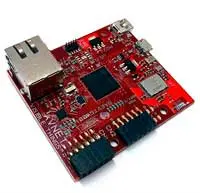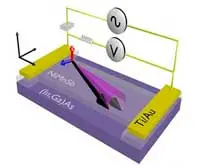Electronics News
Archive : 21 July 2016 год
 Novel functional materials could be integrated on silicon devices, says a team from North Carolina State University, allowing the creation of new smart devices and systems.
Novel functional materials could be integrated on silicon devices, says a team from North Carolina State University, allowing the creation of new smart devices and systems.
The functional materials are oxides, including multiferroic materials, topological insulators and novel ferroelectric materials – all thought to hold promise for applications including sensors, non volatile memory and MEMS.
“These novel oxides are normally grown on materials that are not compatible with computing devices,” said Professor Jay Narayan, pictured. “We are now able to integrate these materials onto a silicon chip, allowing us to incorporate their functions into electronic devices.”
The approach is enabled by two platforms, both of which are compatible with silicon: a titanium nitride platform, for use with nitride based electronics; and yttria stabilised zirconia, for use with oxide based electronics.
Specifically, the team, which included scientists from the US Army Research Office, developed a suite of thin films that connect the silicon chip to the relevant materials by aligning the planes of the crystalline structure in the oxide materials with the planes of the underlying substrate.
With multiferroic materials, researchers use a combination of titanium nitride, magnesium oxide, strontium oxide and lanthanum strontium manganese oxide films. For topological insulators, a combination of magnesium oxide and titanium nitride films is used.
“Integrating novel materials onto silicon chips makes many things possible,” Prof Narayan said. “For example, this allows us to sense or collect data, manipulate that data and to calculate a response – all on one chip. This makes for faster, more efficient, lighter devices.”
It may also be possible to integrate LEDs on silicon chips to make ‘smart lights’.
Author
Graham Pitcher
Source: www.newelectronics.co.uk
 Avnet Silica has forged partnerships with Arkessa, Spica Technologies and UbiquiOS to provide full range of IOT connectivity solutions.
Avnet Silica has forged partnerships with Arkessa, Spica Technologies and UbiquiOS to provide full range of IOT connectivity solutions.
Arkessa provides a secure global connectivity service that gives OEM companies the ability to design, develop and connect smart sensors, embedded devices and gateway solutions over cellular networking technologies, as well as cloud and enterprise software applications.
Spica Technologies offers its devicepoint IoT application framework, which provides a set of composable services that can be configured to deliver any number of IoT solutions.
Finally, UbiquiOS supplies a connectivity platform for embedded wireless applications. The stack makes for easy integration into the leading cloud platforms for presentation of data and management of networks.
Avnet Silica has also signed an agreement with Sierra Wireless to include its entire device to cloud offering in the range of Silica products and services. Avnet Silica now provides Sierra Wireless SIM and Connectivity services, as well as IoT cloud platform services.
“It is important to us to align to and partner with the right suppliers so we are able to offer the right technologies to support our customers,” said Philippe Fremont, vice president of technical marketing, at Avnet Silica. “These new partnerships with data connectivity, cloud services and embedded connectivity software companies, along with the extension of the Sierra Wireless product range available through Avnet Silica, makes us the most well-positioned distributor to offer a full range of technology and services to accelerate the development and deployment of edge-to-enterprise IOT projects."
Author
Peggy Lee
Source: www.newelectronics.co.uk
 Researchers at Johannes Gutenberg University Mainz (JGU) are looking to exploit a novel effect arising from the relativistic physics of Einstein in which magnets can flip themselves through the internal motion of their electrons. The team compares this to the ability of a cat to flip itself in the air by twisting different parts of its body in different directions and land on its feet.
Researchers at Johannes Gutenberg University Mainz (JGU) are looking to exploit a novel effect arising from the relativistic physics of Einstein in which magnets can flip themselves through the internal motion of their electrons. The team compares this to the ability of a cat to flip itself in the air by twisting different parts of its body in different directions and land on its feet.
In particular, the work is focused on a Heusler alloy of nickel, manganese and antimony (NiMnSb). “In these new magnetic materials,” said Professor Jairo Sinova, “a current running through the magnet can change the direction of magnetisation, depending on the direction of the current.” This phenomenon is dubbed spin-orbit torques.
Researchers first observed spin-orbit torques in the artificial bulk diluted magnetic semiconductor GaMnAs. However, these spin-orbit torques were only seen at very low temperatures.
Working with scientists from Prague, Cambridge, Würzburg, Jülich, and Nottingham, Prof Sinova and his team have predicted and demonstrated the effect of spin-orbit torques in NiMnSb crystals at room temperature.
The ability to use single magnet manipulation at room temperature is said to represent an important step towards improved MRAM architectures.
Author
Graham Pitcher
Source: www.newelectronics.co.uk
 Signal processing specialist RFEL is supplying a HyperSpeed FFT IP core to the Arizona Radio Observatory (ARO) for use in a high performance radio astronomy spectrometer system. The core will play a central role in improving sideband separation in heterodyne receivers.
Signal processing specialist RFEL is supplying a HyperSpeed FFT IP core to the Arizona Radio Observatory (ARO) for use in a high performance radio astronomy spectrometer system. The core will play a central role in improving sideband separation in heterodyne receivers.
ARO operates two radio telescopes at millimetre wavelengths, covering seven atmospheric windows from 4mm to 0.4mm and enabling continuum and spectral line observations.
“Radio astronomy is a perfect example of how our expertise can provide solutions that cannot be found elsewhere,” claimed Dr Alex Kuhrt, RFEL's CEO. “Radio telescopes generate huge amounts of data that have to be processed without loss to extract signals. Our HyperSpeed FFT core is configured to match ARO’s demanding research needs, giving the throughput and performance required.”
According to RFEL, the device – which is clocked at 160MHz – performs a fixed length, 8192 point complex Fast Fourier Transform (FFT) with an internal complex data parallelism of 32.
Bit widths are manipulated to ensure mathematical precision is maintained. Convergent rounding will provide the lowest signal to noise ratio (SNR), but with potential structure to the noise. Statistical rounding, meanwhile, will result in a slightly higher SNR, but less structure.
Robert Freund, principal engineer at ARO principal engineer Robert Freund noted: “RFEL is expert at providing cutting edge solutions that push the boundaries, enabling more sensitive solutions.”
Author
Graham Pitcher
Source: www.newelectronics.co.uk
 Mark Lippett has succeeded Nigel Toon as president and CEO of XMOS as the company looks to focus on the development of voice enabled controllers for IoT applications. Toon assumes the role of chairman.
Mark Lippett has succeeded Nigel Toon as president and CEO of XMOS as the company looks to focus on the development of voice enabled controllers for IoT applications. Toon assumes the role of chairman.
Lippett, pictured, most recently the company’s COO, said: “I’m delighted to take up my appointment at such an exciting time for XMOS. A massive change is coming in the way that we engage with the electronics that surround us at home, at work and in the built environment. There will be billions of voice-aware products that we will use to talk to intelligent agents who will inform, entertain and manage our everyday tasks, and XMOS is a leader of many of those changes.”
According to the company, it will be integrating its various technologies – flexible I/O, embedded DSP and control processing – into one device that supports the development of innovative end user products.
XMOS emerged from darkness in 2007 with technology based on research performed at Bristol University by Professor David May. Called software defined silicon, the technology was intended to provide the cost advantages of SoCs with the flexibility of FPGAs. Essentially, the technology relied on tiles of generic 32bit RISC processors with associated memory blocks.
Since then, the company changed its focus to creating devices that competed with microcontrollers and, more recently, to providing voice and music processing and control ICs
Author
Graham Pitcher
Source: www.newelectronics.co.uk

